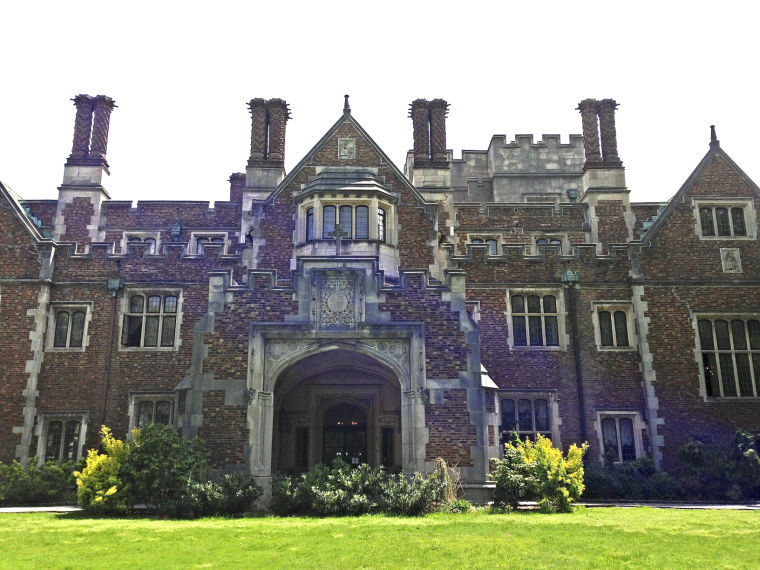The St. Ignatius Retreat House, once located on the sprawling 300-acre Inisfada property off Searingtown Road, was sold and torn down last year and is now just a memory of the North Shore’s Gold Coast history.
And Father Damian Halligan, who served as the house’s spiritual director for more than 20 years, is making sure that memory is kept alive.
Halligan on Thursday gave a lecture at the Manhasset Public Library that spanned Inisfada’s construction in the late 1910s through the waning moments before the wrecking ball demolished the house last December.
“That last year, it was very hard. It felt like a wake,” Halligan said. “It was a wake.”
The retreat house closed on June 2, 2013 and was sold by the New York Province of the Society of Jesus to the Manhasset Bay Group for $36.5 million for the future development of 51 single-family homes. A planning application is currently pending with the Village of North Hills.
Halligan said the money from the project’s sale directly benefited the Jesuit order’s Apostleship of Prayer Building, an infirmary that treats 70 of the province’s priests.
Since the house’s retreats could only accommodate up to 35 people at a time, and applications to expand the house during the latter half of the 20th century were routinely denied, Halligan said the Jesuit order faced problems in increasing revenues amid expanding operating costs.
“Retreat houses have been closing all over the country for the same reasons we did,” Halligan said. “The recession shoe-stringed us.”
Halligan said that when the Manhasset Bay Group’s clients – a conglomerate based in Hong Kong whose identity still remains unknown – visited the property last year, they determined it would cost $10 million just to fix up and even more to maintain.
It would have been a wiser investment to tear the house down than keep it open as a museum – as many residents and Jesuit officials wanted, Halligan said.
During Inisfada’s final days, Halligan said three families who descended from the Brady family that built the house visited the property and questioned why so much of the Gold Coast industrialist’s estate had been left to the Jesuit order in the first place, considering many relatives had struggled through the Great Depression.
“But someday, they’ll appreciate what happened here,” Halligan said.
Nicholas Brady, who inherited a $70 million as part of his industrialist father Anthony Brady’s estate, built Inisfada with his wife Genevieve between 1916-20 as a summer home to compliment their residences in New York City and Rome, Italy.
Artisans, architects and engineers from all over the world descended upon Long Island to assist in the construction of the house, which had 87 rooms across 72,000 square feet, Halligan said.
Over time, the Bradys sold off more than half the property for the construction of the Long Island Expressway and the surrounding Village of North Hills , Halligan said, but the couple frequently entertained high-profile guests throughout their time there, including Cardinal Eugenio Pacelli, who stayed at Inisfada prior to his ascension as Pope Pius XII.
When Nicholas Brady died in 1930, the house was left to Genevieve and then to Manhattan’s St. Ignatius Jesuit parish in 1937, Halligan said.
Halligan said the Jesuits had faced financial problems resulting from the Great Depression, and the race was on between other local Catholic provinces to secure revenues from Long Island’s religious folk.
Inisfada was initially used by the Jesuits as a seminary and later became the St. Ignatius Retreat House, but Halligan said the Jesuits continued selling off bits of the property until only 33 acres remained.
By 1998, when Halligan arrived, Inisfada’s annual operating costs rose to hundreds of thousands of dollars, and the Jesuit order put St. Ignatius on the housing market in 2012 after struggles to meet its expenses worsened during the housing market crisis and ensuing recession.
“The people of Manhasset and Port Washington really kept this place open,” he said, citing one family from Manhasset’s Village of Plandome that donated more than $800,000 to Inisfada.
Following the house’s sale, many of Inisfada’s interior furnishings were donated to Fordham University, including the St. Genevieve chapel currently packed away in storage, and others were sold at auction in November.
Area residents and organizations tried unsuccessfully to prevent the property’s sale and keep Inisfada standing, circulating an application to place the house on the National Register of Historic Places and attempting to file and injunction against the Jesuit order’s transaction with the Manhasset Bay Group.
But all that remains of Inisfada today, Halligan said, is a walking tour of the stations of the cross, the massive front gates that close off the property from the public, and the memory of the house that once stood off in the distance.
“The only way I could was celebrate all the good that was done,” he said.



